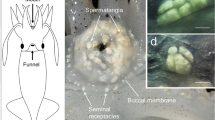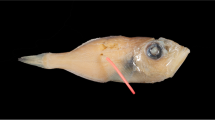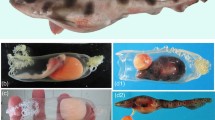Spying on a brooding deep-sea squid reveals that it cradles and aerates its eggs while they mature.
Abstract
Gonatus onyx is one of the most abundant cephalopods in the Pacific and Atlantic Oceans1 and is an important prey species for a variety of vertebrate predators2,3, but a full understanding of its life history has been hampered because spawning occurs at great depths4,5, where observation is difficult. Here we describe post-spawning egg care, or brooding, in this deep-sea squid. Our finding is unexpected because this behaviour differs from the reproductive habits of all other known squid species.
Similar content being viewed by others
Main
It was initially assumed that gonatids, like other squids, deposited their eggs on the sea floor and left them to develop on their own1. A pelagic egg-brooding habit had been proposed for gonatid squids6, but could not be verified in the absence of direct observation. It had also been questioned because some aspects of the squids' biology seem to preclude brooding7 — principally, the degeneration of musculature following sexual maturation was presumed to limit locomotion and render squids unfit for egg protection5,7.
However, we observed five squids, each holding an egg mass in its arms, at depths between 1,539 and 2,522 m in Monterey Canyon, off California, accessed with the ROV Tiburon8. Eggs or hatchlings and two adults were collected. The squids used hooks on their arms to hold the egg mass, which consists of two thin membranes in a continuous flat sheet, open at both the distal and proximal ends. The egg mass forms a hollow tube that extends from the mouth to well beyond the end of the arms and contains about 2,000–3,000 eggs (Fig. 1a, b).
Mantle length is about 145 mm. a, The squid in a horizontal resting position at 2,522 m depth. b, Squid holding a tubular egg mass, and c, hatchlings being released at 1,539 m depth. d, e, Hatched embryos (about 3 mm in length) at d, an intermediate stage of development, and e, an advanced stage of development. The in situ temperature (1.7–3.0 °C) and oxygen concentration (45–90 µmoll−1) were measured using a SeaBird SBE-9 conductivity–temperature–depth unit with an oxygen sensor. Additional visual observations (see movie in supplementary information) were recorded with a high-resolution, three-chip video camera transmitting to the RV Western Flyer by fibre-optic cable. Assisted by vessel crew and ROV pilots.
Repeated extension of the arms (at intervals of about 30 to 40 s) flushed water through the egg mass: this behaviour probably served to aerate the eggs in the hypoxic midwaters found off California9,10. Aggressive arm movements and escape swimming caused partial disintegration of the more mature egg masses and hatching of the released eggs (Fig. 1c–e). (For movies, see supplementary information.)
The escape responses seen here, considered with the apparent stage of egg development, indicate that the squid may have undergone a gradual degeneration of locomotory capacity. For example, a specimen bearing undeveloped eggs made a vigorous escape by using fin and mantle contractions, whereas those with advanced embryos (Fig. 1e) showed only respiratory mantle contractions and did not move away; another squid with eggs at an intermediate stage of development retained some locomotory ability (Fig. 1d) (for movies, see supplementary information). Activities of metabolic enzymes in locomotory muscles of spawned female G. onyx are lower in specimens that have more advanced embryos5.
Low temperature and large eggs will prolong development in G. onyx7,11. The abundance of juveniles in near-surface waters peaks seasonally from April through to July1, which may indicate a yearly cycle with an egg-development period of 6 to 9 months5,6. This estimate is roughly consistent with the timing of our observations. Gonatid squids have sufficient lipid stores to fuel metabolism for a long brooding period, and the gradual decline in mantle muscle and digestive-gland condition indicates a progressive use of energy stores over a long egg-brooding period6. However, two specimens captured within days of each other carried embryos at different stages, so development is apparently not well synchronized.
We have demonstrated active post-spawning egg care in G. onyx and this is, to our knowledge, the first case reported in squids. The value of this strategy in the deep sea is supported by strong convergence with distantly related taxa12 and we expect it to be found in other squids. Despite retaining some capacity for swimming, the relatively immobile brooding squids are found within the usual diving range of whales and elephant seals and so may provide an easy target for such ‘mesopelagic’ mammals13. Gonatid squids and other ontogenetic migrators therefore represent a direct energetic, as well as trophic, link between deep and shallow biomes.
References
Okutani, T., Kubodera, T. & Jefferts, K. Bull. Ocean. Res. Inst. Univ. Tokyo 26, 159–192 (1988).
Clarke, M. R. Phil. Trans. R. Soc. Lond. B 351, 979–983 (1996).
Hooker, S. K., Whitehead, H. & Gowans, S. Biol. Conserv. 104, 51–48 (2002).
Arkhipkin, A. I. & Bjorke, H. Polar Biol. 22, 347–365 (1999).
Hunt, J. C. & Seibel, B. A. Mar. Biol. 136, 543–552 (2000).
Seibel, B. A., Hochberg, F. G. & Carlini, D. B. Mar. Biol. 137, 519–526 (2000).
Nesis, K. N. Russ. J. Mar. Biol. 25, 499–506 (1999).
Robison, B. H. Mar. Technol. Soc. J. 26, 32–39 (1993).
Strathmann, R. R. & Strathmann, M. F. J. Mar. Biol. Assoc. UK 75, 413–428 (1995).
Childress, J. J. & Seibel, B. A. J. Exp. Biol. 201, 1223–1232 (1998).
Boletzky, S. V. Antarctic Sci. 6, 139–142 (1994).
Childress, J. J. & Price, M. H. Mar. Biol. 76, 165–177 (1983).
Hochachka, P. W. Experentia 48, 570–574 (1992).
Author information
Authors and Affiliations
Corresponding author
Ethics declarations
Competing interests
The authors declare no competing financial interests.
Supplementary information
S1 Movie
Gonatus onyx (Cephalopoda: Teuthoidea). Egg-brooding female squid swimming away from the submersible, ROV Tiburon (Monterey Bay Aquarium Research Institute). Eggs can be seen hatching at the distal end of the egg mass. Filmed on Dive 239 at 2,400 m, 16 November 2000. (MOV 3382 kb)
S2 Movie
Gonatus onyx (Cephalopoda: Teuthoidea). Female with eggs in an early stage of development exhibiting an aggressive escape response from the submersible. No hatching was observed. Dive 437, 2522 m, 11 June 2002. (MOV 4558 kb)
S3 Movie
Gonatus onyx (Cephalopoda: Teuthoidea). Female with eggs at an advanced stage of development making no apparent escape response from the submersible. The brooding female triggers premature hatching of eggs by expanding and contracting the arms. Dive 409, 1539 m, 20 March 2002. (MOV 5323 kb)
Rights and permissions
About this article
Cite this article
Seibel, B., Robison, B. & Haddock, S. Post-spawning egg care by a squid. Nature 438, 929 (2005). https://doi.org/10.1038/438929a
Published:
Issue Date:
DOI: https://doi.org/10.1038/438929a
This article is cited by
-
A practical staging atlas to study embryonic development of Octopus vulgaris under controlled laboratory conditions
BMC Developmental Biology (2020)
-
Reproductive strategies of deep-sea squid (Mastigoteuthidae, Chiroteuthidae, Batoteuthidae and Cranchiidae)
Marine Biology (2019)
-
Mating tactics in the sub-Antarctic deep-sea squid Onykia ingens (Cephalopoda: Onychoteuthidae)
Polar Biology (2016)
-
Fecundity, oogenesis, and ovulation pattern of southern African Lycoteuthis lorigera (Steenstrup, 1875)
Hydrobiologia (2014)
-
Cephalopod neurobiology: an introduction for biologists working in other model systems
Invertebrate Neuroscience (2013)
Comments
By submitting a comment you agree to abide by our Terms and Community Guidelines. If you find something abusive or that does not comply with our terms or guidelines please flag it as inappropriate.




